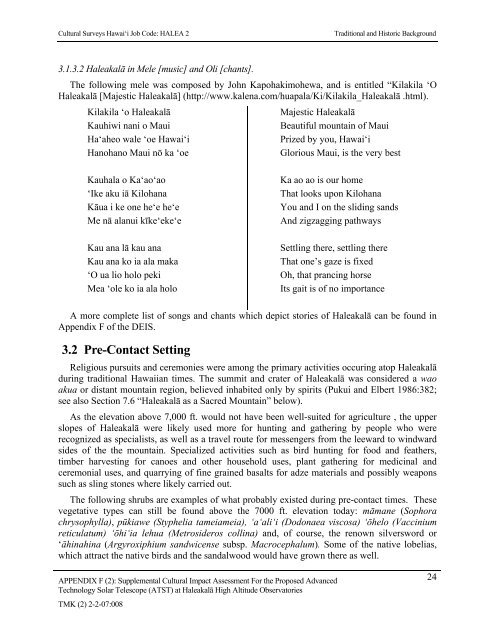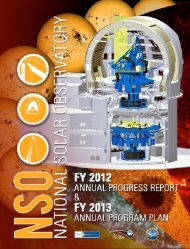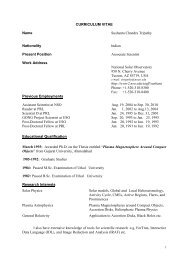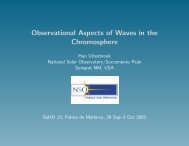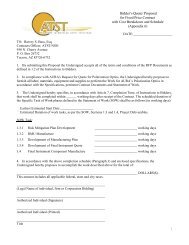F2 - ATST
F2 - ATST
F2 - ATST
Create successful ePaper yourself
Turn your PDF publications into a flip-book with our unique Google optimized e-Paper software.
Cultural Surveys Hawai‘i Job Code: HALEA 2Traditional and Historic Background3.1.3.2 Haleakalā in Mele [music] and Oli [chants].The following mele was composed by John Kapohakimohewa, and is entitled “Kilakila ‘OHaleakalā [Majestic Haleakalā] (http://www.kalena.com/huapala/Ki/Kilakila_Haleakalā .html).Kilakila ‘o HaleakalāKauhiwi nani o MauiHa‘aheo wale ‘oe Hawai‘iHanohano Maui nō ka ‘oeMajestic HaleakalāBeautiful mountain of MauiPrized by you, Hawai‘iGlorious Maui, is the very bestKauhala o Ka‘ao‘ao‘Ike aku iā KilohanaKāua i ke one he‘e he‘eMe nā alanui kīke‘eke‘eKau ana lā kau anaKau ana ko ia ala maka‘O ua lio holo pekiMea ‘ole ko ia ala holoKa ao ao is our homeThat looks upon KilohanaYou and I on the sliding sandsAnd zigzagging pathwaysSettling there, settling thereThat one’s gaze is fixedOh, that prancing horseIts gait is of no importanceA more complete list of songs and chants which depict stories of Haleakalā can be found inAppendix F of the DEIS.3.2 Pre-Contact SettingReligious pursuits and ceremonies were among the primary activities occuring atop Haleakalāduring traditional Hawaiian times. The summit and crater of Haleakalā was considered a waoakua or distant mountain region, believed inhabited only by spirits (Pukui and Elbert 1986:382;see also Section 7.6 “Haleakalā as a Sacred Mountain” below).As the elevation above 7,000 ft. would not have been well-suited for agriculture , the upperslopes of Haleakalā were likely used more for hunting and gathering by people who wererecognized as specialists, as well as a travel route for messengers from the leeward to windwardsides of the the mountain. Specialized activities such as bird hunting for food and feathers,timber harvesting for canoes and other household uses, plant gathering for medicinal andceremonial uses, and quarrying of fine grained basalts for adze materials and possibly weaponssuch as sling stones where likely carried out.The following shrubs are examples of what probably existed during pre-contact times. Thesevegetative types can still be found above the 7000 ft. elevation today: māmane (Sophorachrysophylla), pūkiawe (Styphelia tameiameia), ‘a‘ali‘i (Dodonaea viscosa) ‘ōhelo (Vacciniumreticulatum) ‘ōhi‘ia lehua (Metrosideros collina) and, of course, the renown silversword or‘āhinahina (Argyroxiphium sandwicense subsp. Macrocephalum). Some of the native lobelias,which attract the native birds and the sandalwood would have grown there as well.APPENDIX F (2): Supplemental Cultural Impact Assessment For the Proposed Advanced 24Technology Solar Telescope (<strong>ATST</strong>) at Haleakalā High Altitude ObservatoriesTMK (2) 2-2-07:008


